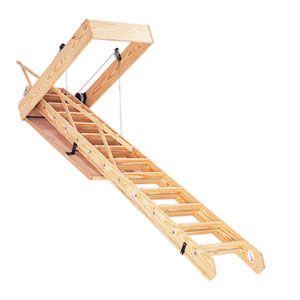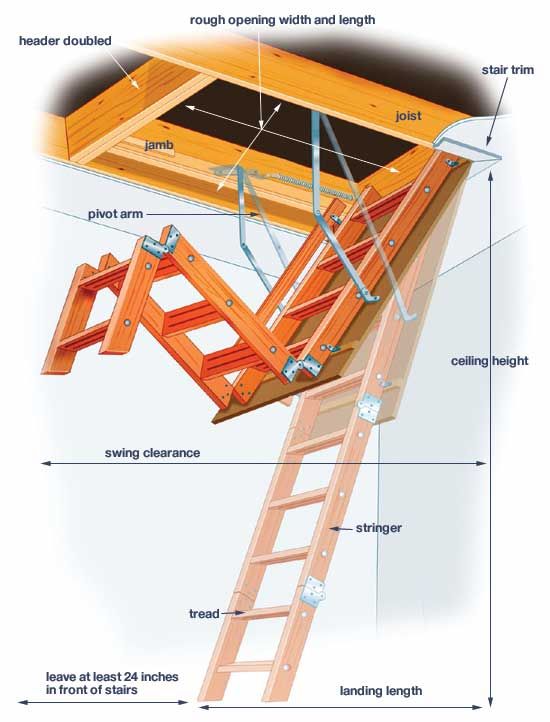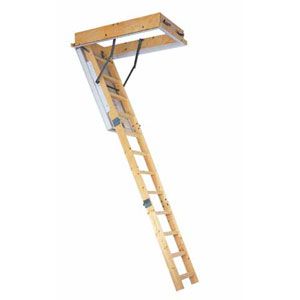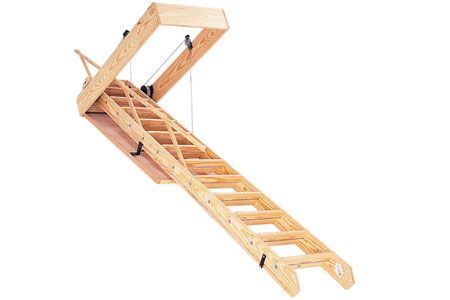Disappearing stairs offer a sleek, space-saving solution that provides convenient access to your attic while seamlessly blending into your home’s architecture when not in use.
In this comprehensive guide, we’ll explore the world of disappearing stairs, from types and installation to maintenance and cutting-edge designs.

Types of Disappearing Attic Stairs
Disappearing stairs come in several varieties, each with its own set of features and benefits. Understanding the different types can help you choose the best option for your home.
Folding Attic Stairs
Folding attic stairs are the most common type of disappearing stairs. These stairs typically consist of two or three hinged sections that fold up into the ceiling when not in use. When extended, they provide a sturdy staircase for easy attic access. Folding stairs are often made of wood or aluminum and can support significant weight capacities.
“An attic stair is a ladder,” says Tom Silva, general contractor for This Old House. “You wouldn’t use a broken ladder, and you definitely shouldn’t use a broken attic stair. Replace or repair it immediately. “
Sliding Attic Stairs
Sliding attic stairs operate on a track system, allowing them to slide out from the ceiling opening when needed. These stairs are often ideal for spaces with limited clearance, as they don’t require the swing room that folding stairs do. They can also be an excellent choice for closets or other tight spaces where traditional folding stairs might not fit.
Telescoping Attic Stairs
Telescoping attic stairs feature a unique design that extends and retracts like a telescope. These stairs are typically aluminum and offer a modern, sleek appearance.
They’re a popular choice for homeowners who want a more contemporary look.

Choosing the Right Disappearing Stairs
Several factors, including measurements, weight capacity, and material options, will determine which disappearing stairs are best for your home.
Measuring Your Space
Before you begin working on your stairs, you’ll need to measure the rough opening in your ceiling, as well as the floor-to-ceiling height. Most manufacturers provide detailed product specifications, so having precise measurements will ensure a proper fit.
To measure the rough opening, take measurements at both the top and bottom of the framing in three different spots. Choose a stair that fits the smallest of these measurements to ensure a proper fit. For ceiling height, measure from the floor to the bottom of the ceiling joists where the stairs will be installed.
Weight Capacity Considerations
Look for stairs with a load rating of at least 300 pounds to ensure they can safely support users and any items carried to or from the attic. Higher weight capacities often indicate more robust construction in treads, stringers, and hinges. If you intend to place heavy objects into your attic, you’ll want to look for stairs with a higher weight capacity.
Material Options
Disappearing stairs are available in various materials, each with its own advantages:
- Aluminum: Lightweight and durable, aluminum stairs are rust-resistant and require minimal maintenance.
- Steel: The strongest option, steel stairs can support the highest weight capacities but may be more expensive.
- Wood: Often the most affordable option, wood stairs offer a traditional look and can be painted to match your decor.
Installation and Safety Considerations
Proper procedure and safety are paramount when installing disappearing stairs. Whether you’re considering a DIY approach or looking to hire a professional, understanding the process and safety guidelines is crucial.
DIY Installation Tips
For those with DIY experience, installing disappearing stairs can be a manageable project. Here are some key tips:
- Ensure you have the right tools and a helper before starting.
- Follow the manufacturer’s instructions carefully.
- Use shims to level the frame and ensure a tight fit.
- Double-check all connections and moving parts before use.
Remember, if you’re unsure about any aspect of the installation, it’s best to consult a professional.
Professional Installation: When To Consider It
Professional installation may be the best choice in several scenarios:
- If you’re uncomfortable with overhead work or lifting heavy objects
- When structural modifications are needed to accommodate the stairs
- If you’re installing a complex or high-end model
Professional installers have the experience and tools to ensure your stairs are installed safely and correctly.
Safety Features To Look For
When selecting disappearing stairs, prioritize models with built-in safety features such as:
- Handrails or grab bars
- Insulated doors to improve energy efficiency
- Locking mechanisms to prevent accidental opening
- Non-slip treads
Maintaining Your Disappearing Stairs
Regular maintenance is essential to keep your disappearing stairs functioning safely and smoothly. Proactive repairs can prevent issues and extend the life of your stairs.
Regular Inspection Checklist
Perform these checks regularly to ensure your stairs remain in good condition:
- Check hinge nuts and bolts for tightness
- Inspect springs for secure anchoring
- Examine pivot arms for straightness
- Verify treads and stringers are intact
- Test the overall stability of the stairs
“An attic stair shouldn’t move at all under your weight,” advises Tom Silva.
Common Issues and Fixes
Some common problems with disappearing stairs include:
- Damaged treads: Replace worn or cracked treads promptly.
- Loose hardware: Tighten any loose nuts, bolts, or screws.
- Misaligned doors: Adjust the frame or replace the weatherstripping for a better seal.
- Stiff operation: Lubricate moving parts with a silicone-based lubricant.
Alternatives To Traditional Attic Stairs
While disappearing stairs are an excellent solution for many homes, alternative options may better suit certain spaces or preferences.
Spiral Staircases
Spiral staircases offer a permanent, old-world look and provide easy access to upper floors or attics. These stairs have a unique look, but they can be difficult to navigate and aren’t good for hauling objects, making carrying furniture up them difficult.
Our All About Stairs article can provide more information on various staircase options, including spiral designs.
Alternating Tread Stairs
Alternating tread stairs, also known as space-saver stairs, offer a unique solution for tight spaces. These stairs feature alternating left and right treads, allowing for a steeper climb in a smaller footprint. While they require some adjustment in use, they can be an excellent option for accessing lofts or attics in compact areas.
Cost Considerations
The cost of disappearing stairs can vary widely based on type, material, and features. Below, we’ll break down the costs of different disappearing stair installations.*
Budget-Friendly Options
For those on a tighter budget, consider:
- Basic wooden folding stairs: Often the most affordable option, starting around $500 to $900.
- DIY installations: You can save $1,000 to $5,000 in labor costs by installing stairs yourself.
High-End Features and Their Value
Premium disappearing stairs may offer:
- Automatic opening and closing mechanisms
- Enhanced insulation for better energy efficiency
- Higher-end stair brackets
- Custom finishes to match your home’s decor
*All cost information in this article is sourced from Angi.
Our Conclusion

Disappearing stairs offer an elegant and practical solution for attic access. By understanding the various types, installation considerations, and maintenance requirements, homeowners can choose the best option for their needs and benefit from long-lasting performance.
Whether you opt for a simple folding model or a high-tech telescoping design, disappearing stairs can significantly enhance your home’s functionality. Remember to prioritize safety features and regular maintenance to keep your attic access secure and reliable for years to come.
Where To Find It
Wood folding stair:
Airtight Attic Access Ladder
Resources Conservation Technologies
Baltimore, MD
410-366-1146
www.conservationtechnology.com
Metal folding stair:
Model #2200
Werner, Co.
Greenville, PA
724-588-8600
Our thanks to:
Dale King, Werner Ladder Company

